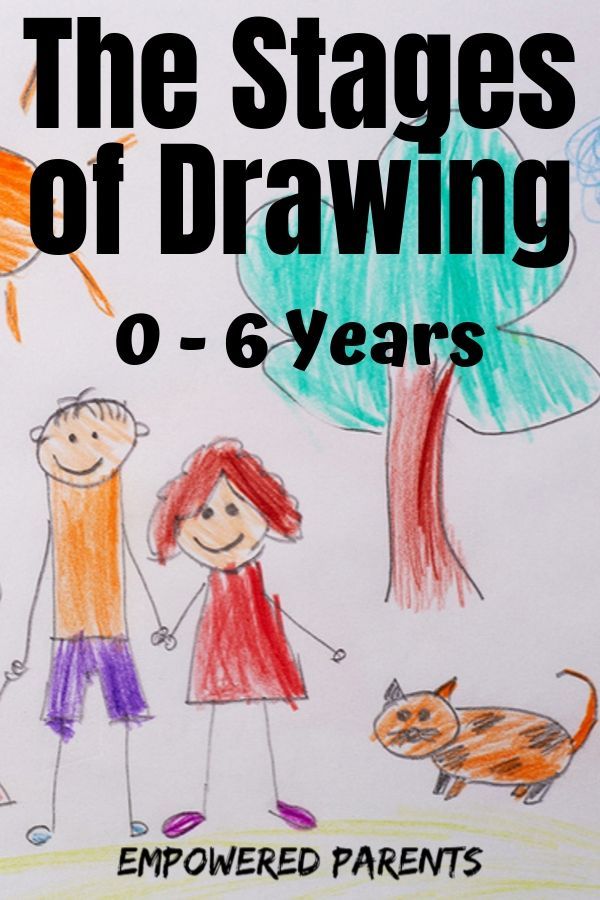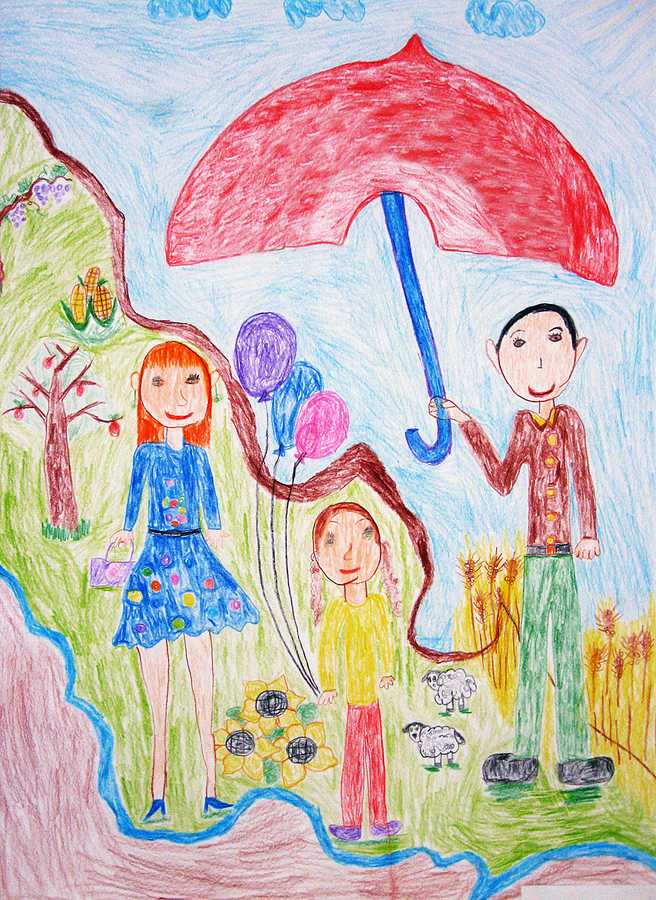Coloring Book Toys for Children How to Draw Toy Rubiks Cube Duck Art Colours for Kids

Here is a cursory overview of the fascinating stages of drawing in child evolution and why it's important to encourage young children to draw.
Drawing is a natural process for all children. From infancy, children begin by experimenting with drawing tools and making marks on paper, and as they abound, these marks start taking on meaning.
Drawing ultimately becomes a child's way of expressing their understanding of the world and all the things that are important to them.
Observe out how children acquire to depict and why information technology'south a crucial activity. There is also a breakdown of the stages of drawing development at various ages.
How to Teach a Child to Draw
During the early years, It'due south important to focus on the procedure of creative cartoon, and not on the product.
There is no demand to formally teach children to depict. The best way to teach them is to give them exposure to materials and drawing tools and let them express themselves freely.
Equally they abound and mature, their drawings will go more than detailed and reflect the world around them.
Avert the temptation to provide models for children to re-create and limit their exposure to colouring books . These only serve to take away natural creativity.

Why Drawing is Important
There are many benefits of drawing during the toddler and preschool years. Information technology:
- builds a child'southward fine motor skills
- develops manus-eye coordination
- develops artistic expression through gratuitous drawing
- is the foundation of pre-writing skills
- builds a kid's attention span
- develops cerebral understanding of concepts
Tracing pictures or "teaching" a child to draw past post-obit models are not natural, historic period-advisable ways to develop creativity.
The Stages of Drawing
Here are the characteristics of the various developmental stages of children's drawings. These are not set up in rock as children develop at their own unique rates.
They will reach the milestones at their own pace, however, they all progress through the same stages, which are based on their level of agreement.
The characteristics are listed by age.
Watch the video below for a summary of each stage, or read on for a breakdown of the various ages.
P.S. Download your Costless set of printables at the stop of the mail service. At that place are games that will assist develop visual perception and fine motor control, both important in the development of cartoon.
12 Months: Random Marks and Scribbles
The get-go stage of drawing is about exploring and developing motor coordination.
At around 15 to 18 months babies brainstorm to develop uncontrolled scribbles that don't correspond anything.
Shapes
Babies begin by making random marks and presently begin to course:
- scribbles
- vertical and horizontal lines
- multiple line drawings
Understanding
For babies, drawing is really about learning crusade and event and their ability to brand things happen.
It has little to do with creating and representing their world, and more than to do with enjoying their movements and the furnishings of them.
Their scribbles enable them to acquire about the backdrop of objects, materials and tools such as pencils, pens, paint, crayons and paper.
Grip
From around fifteen months of age, toddlers are ordinarily able to grasp crayons with their whole mitt (called a palmar grasp).
2 Years: Controlled Scribbles
This stage is known equally controlled scribbling .
Information technology is characterized by spontaneous circular or to-and-fro scribbles and dots.
Similar scribbles can be found in all children's drawings at this historic period and the shapes in them are necessary for developing drawing and writing skills later on.
Shapes
Toddlers begin to make drawings that include:
- horizontal and vertical lines
- multiple loops and spirals
- roughly fatigued circles
- shapes that resemble letters T and V

Grip
2-twelvemonth-olds learn to concur a pencil well down the shaft towards the bespeak, using their thumb and first two fingers (called a tripod grasp).
They volition ordinarily use their preferred hand.
Understanding
At this age, toddlers begin to detect the connection between the movements they make and the marks that form on the paper. They will begin to echo movements on purpose.
By the finish of this year, these drawings evolve into elementary diagrams .
three Years: Basic Shapes
During this stage, children brainstorm to use bones shapes in their drawings equally their fine motor control and hand-eye coordination meliorate.
Shapes
Drawings at this age include the following shapes, combined in different ways:
- circles and squares
- crosses
- dots
- shapes that resemble letters T, V and H
Drawing of a person
The first cartoon of a person commonly emerges around 3 or 4 years of age.
These 'tadpole' people are fatigued with but a head and usually legs directly fastened to the head.
Grip
A three-year-onetime holds a pencil nearly the tip, between the beginning two fingers and the pollex.
They utilise the preferred mitt and hold the pencil with good control.
At this age, you can aid your kid develop a skillful tripod grasp past using triangular crayons.
Understanding
At this age, children are able to tell you what their scribbles represent, although y'all may not be able to see what they take described.


They usually name their film while drawing information technology or later it is complete, but they do non kickoff a drawing with a clear programme for what they volition draw.
The use of colour at this phase is unrealistic and they often prefer to use only one colour.
4 Years: Patterns and 'Polliwog' People
By 4 years of age, patterns start emerging in children'due south drawings. A child will brand a pattern and translate it equally a representation of something, giving it a characterization.
Shapes
Their drawings include:
- Squares, circles and rectangles
- Attempts at triangles and diamonds, although she may not be able to course them nonetheless
- Crosses
- Letters (pretend writing)
Drawing of a person
A 4-year-old's drawing of a person will progress from a head with legs to include details such as eyes – since eye contact is important to them.
They draw not what they come across, but what they know, and will add details as they get important to them.
Details such as arms, fingers and a trunk emerge.
Drawing other images
By iv-and-a-half they begin to combine ii or more shapes or forms together to class basic images, such as a rectangle and a circle to form a hat. They frequently learn this from adults.
The showtime shapes children make consistently volition commonly form people, but later includes basic images such equally a business firm or sun.
Grip
At this stage, they hold a pencil with practiced control, in an adult fashion.
Understanding
Drawing takes on more than meaning and intention. Children usually make up one's mind what they are going to draw before they begin.
They deliberately try to combine shapes and lines together and their pictures start to look similar the images they describe.
5 Years: Pictures and Portraits
five-year-olds brainstorm to bear witness much creativity in their drawings.
Shapes
Their drawings will include:
- Basic shapes
- Triangles and diamonds
- Spontaneous messages (to imitate writing)
Cartoon of a person
A portrait of a person emerges, with many details such every bit pilus, hands and fingers, feet and a body.
Drawing other images
They describe images such as animals, houses, vehicles, trees, plants, flowers and rainbows.
They are able to include details – such every bit drawing a house with a door, windows, roof and chimney.

Grip
By 5 years of age, children should have developed good control when belongings a pencil, crayon or paintbrush.
Understanding
Children volition now describe spontaneously and begin to evidence their own background, interests and experiences in their drawings. They draw what they know.
Their representation of people, animals and houses changes constantly.
They volition also name their picture before beginning.
They tin can color within the lines only their employ of colour may even so be unrealistic.
At this point, people and objects may however be floating in the air as children are still developing spatial perception.
They unremarkably place themself in the middle of a cartoon due to their egocentric nature (seeing themselves as the centre of the globe).
6 Years: Drawings Stand for Interests and Feel
By half-dozen or vii years, children have their ain manner of drawing, which can commonly be recognized by adults.
Shapes
By the time they are 7, they volition be able to form proficient circles, squares, rectangles, triangles and diamonds in his drawings.
Cartoon of a person
A kid unremarkably settles on a sure representation of a person at this age and tends to describe them all with the same basic shape.
For example, they will depict the whole family with the same body outline but will make the members of the family unit different sizes and testify gender with hair and apparel.

Drawing other images
Drawings represent all kinds of animals and things, usually those that interest them the most.
They tend to draw animals with human-like faces.
Understanding
At this stage, children evidence their higher level of cognition by drawing people, animals and objects on a baseline, such as on the ground or grass.

They also testify perception by cartoon, for example, trees higher than the house or flowers that are small.
This drawing shows a child's greater understanding of depth and distance.

The way they see the world comes through their drawings. They exit out unimportant things and enlarge things that are important to them.
They may depict a small door on a house, but big enough for themselves, or very high windows, since they cannot reach them.
They can also show move in their drawings by portraying objects that are flying or drawing the legs of an animate being wider apart if running.
Their use of colour becomes quite realistic.
I hope you've enjoyed reading almost the stages of drawing development in young children and are inspired to encourage your children to exercise lots of free cartoon and creative expression.
Sources:
Hendrick, H . 1990. Total Learning: Developmental Curriculum for the Immature Kid . Third Edition. Macmillan Publishing Company: New York.
Pieterse, M. 2007. Linguistic communication and School Readiness . Metz Press: Welgemoed.
Natanson, J. 1998. Learning Through Play: A parent'southward guide to the first 5 years. Tafelberg Publishers Express: Cape Boondocks.
Fisher, B. 1991. Joyful Learning: A Whole Language Kindergarten. Heinemann: New Hampshire.
Get instant access to FREE educational printables here. You'll receive puzzles, sequencing cards, 'find my mom' cards, memory games, lotto games and a pack of short stories.
Would you like a year of done-for-you, ten-minute activities to teach your three-v-year-old through play? Go your copy of the Learning Through Play Activity Pack for only $27.

Source: https://empoweredparents.co/child-development-drawing-stages/

0 Response to "Coloring Book Toys for Children How to Draw Toy Rubiks Cube Duck Art Colours for Kids"
Enviar um comentário